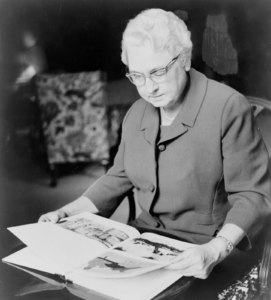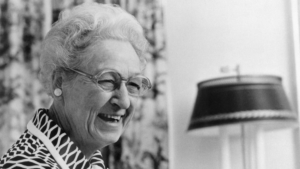Virginia Apgar interesting facts
The Woman Who Gave Babies Their First Grade: Virginia Apgar’s Revolutionary Compassion

On an ordinary morning in the early 1950s, Dr. Virginia Apgar sat in the cafeteria of Columbia-Presbyterian Hospital, listening to a medical resident voice his frustration. “How can we really know which newborns need help?” he asked. In that moment, Apgar reached for the nearest piece of paper—a laminated sign reading “Please bus your own trays“—and sketched a five-point system that would become the universal language of newborn survival. This wasn’t just a clinical innovation; it was the culmination of a lifetime defying limitations to hear the faintest cries of the vulnerable.
Breaking Barriers: The Making of a Medical Maverick
Born in 1909 in Westfield, New Jersey, Virginia Apgar’s path to medicine was forged through early encounters with mortality. Her father’s amateur science experiments sparked her curiosity, but it was her brothers’ suffering—one lost to tuberculosis, another chronically ill—that seeded her determination to heal. At Mount Holyoke College, she balanced zoology studies with rounding up stray cats for labs and playing violin in the orchestra—a testament to her relentless energy.
Medical school at Columbia in 1929 placed her among just nine women in a class of ninety. Graduating fourth in her class in 1933, she aspired to become a surgeon. But the field’s gender barriers proved insurmountable. Her mentor, Dr. Allen Whipple, delivered sobering advice: “Even women with stellar records fail in surgery. Consider anesthesiology—it’s embryonic, and you could shape it“. It was a pivot that would redirect medical history.
Her training exposed medicine’s ingrained inequities. Arriving in Wisconsin to study under anesthesia pioneer Dr. Ralph Waters, she discovered no housing for female trainees. She slept in Waters’ office for two weeks before being moved to the maids’ quarters. Yet by 1938, she returned to Columbia as the first woman to direct the Division of Anesthesiology—a role she described in a letter to Waters: “By the second week I was ready to turn to law, to dressmaking, anything but anesthesia. After numerous mistakes I remembered you had cautioned me… but somehow you must learn by making them yourself”.
The “Bus Your Trays” Breakthrough: Birth of the Apgar Score

By 1949, Apgar became Columbia’s first female full professor. But her most urgent mission emerged in delivery rooms. While U.S. infant mortality declined, deaths within the first 24 hours remained stubbornly high. Nurses and doctors relied on subjective impressions (“looks pale” or “seems floppy”), leading to inconsistent care. Apgar recognized that standardized assessment could bridge the gap between life and death.
Working with colleagues, she distilled newborn viability into five measurable signs:
- Appearance (skin color)
- Pulse (heart rate)
- Grimace (reflex response)
- Activity (muscle tone)
- Respiration (breathing effort)
Table: The Apgar Score System
| Criterion | Score 0 | Score 1 | Score 2 |
|---|---|---|---|
| Appearance | Blue/pale all over | Pink body, blue extremities | Pink all over |
| Pulse (bpm) | Absent | Below 100 | Above 100 |
| Grimace | No response | Grimace/weak cry | Vigorous cry/cough |
| Activity | Limp | Some flexion | Active motion |
| Respiration | Absent | Slow/irregular | Strong cry |
| *Source: Adapted from Cureus (2024)* | |||
Beyond the Score: The Unseen Battles
Apgar’s innovation masked profound personal struggles. As a woman leading an emerging specialty, she fought for resources and recognition. When Columbia established its anesthesia department in 1949, her colleague Dr. Emmanuel Papper was appointed chair—likely due to her focus on clinical work over research. Yet she channeled frustration into advocacy, training a generation of anesthesiologists while assisting in over 2,000 deliveries.
Her score also catalyzed research into obstetric anesthesia. Collaborating with Dr. Duncan Holaday and Dr. Stanley James, she discovered that cyclopropane anesthesia depressed newborns’ blood oxygen levels. Her findings led to the agent’s discontinuation in obstetrics, proving that assessment drives intervention, and intervention drives reform.
Reinvention: From Assessment to Advocacy
At age 50, Apgar made a radical shift. She earned a Master’s in Public Health from Johns Hopkins and joined the March of Dimes (then the National Foundation for Infantile Paralysis). As director of congenital defects research, she transformed the organization’s focus from polio to birth defects prevention.
Her approach was revolutionary:
- Democratized Education: She authored Is My Baby All Right? (1973), a bestselling guide for parents, and answered personal letters from anxious families.
- Policy Advocacy: She lobbied for universal rubella vaccination after the 1964–65 pandemic caused 20,000 birth defects.
- Research Mobilization: She funded early genetic studies and promoted Rh factor testing to prevent hemolytic disease in newborns.
Touring the country, she spoke with equal clarity to rural mothers and academic conferences. “Babies,” she declared, “are the best way to get people’s checkbooks out“. Under her leadership, March of Dimes funding doubled, cementing her legacy as a bridge between bench and bedside.
Virginia Apgar Legacy: Triumphs and Tensions
Limitations Revealed
- Preterm Bias: Scores often underestimate viability in premature infants due to innate immaturity.
- Subjectivity: Inter-rater reliability is moderate; clinicians often disagree on “grimace” or “color” scores.
- Predictive Gaps: Low 5-minute scores correlate with cerebral palsy risk but most low-scoring infants develop normally.
Equity Challenges
A 2024 review exposed a critical flaw: Skin color assessment risks racial bias. Cyanosis detection is harder in darker-skinned infants, potentially lowering scores unfairly. U.S. data confirms Black newborns are less likely to receive 10/10 scores, even accounting for clinical factors. Modern guidelines now emphasize pulse oximetry over visual checks.
Misinterpretations
The score was weaponized in malpractice lawsuits as “proof” of birth asphyxia—a distortion Apgar despised. As ACOG guidelines clarify: “The Apgar score alone cannot diagnose asphyxia“.
Virginia Apgar: Music, Mischief, and Mastery
Amid professional pressures, Apgar’s vitality was legendary. She gardened obsessively, fished with surgeons, and built string instruments. In a famed act of rebellion, she stole a maple phone-booth shelf to craft a viola back. When the replacement wood proved too long, she sawed it in a women’s lounge while a colleague stood guard.
Her correspondence reveals self-deprecating wit. When Dr. Joseph Butterfield coined the APGAR backronym, she replied: “I chortled aloud… A secretary once told me, ‘I didn’t know Apgar was a person, I thought it was just a thing’“. Later, she dismissed attempts to link scores to IQ: “It does no harm to investigate… but I’d expect no association“.
Virginia Apgar Trailblazing Timeline
| Year | Milestone | Impact |
|---|---|---|
| 1933 | Graduates 4th in class at Columbia | Enters medicine amid gender barriers |
| 1938 | First woman to direct anesthesia division | Challenges surgical hierarchy |
| 1949 | First female full professor at Columbia | Breaks academic glass ceiling |
| 1952 | Develops Apgar Score on a napkin | Revolutionizes neonatal assessment |
| 1959 | Joins March of Dimes | Shifts focus to birth defects prevention |
| 1973 | Publishes Is My Baby All Right? | Empowers parents with scientific knowledge |
Virginia Apgar Eternal First Responder
Apgar died in 1974, but her work pulses through every delivery room. Her score, refined yet fundamentally unchanged, remains medicine’s most elegant triage tool. Google honored her with a Doodle; textbooks enshrine her; orchids bear her name. Yet her true legacy is the ethos she embodied: that science without compassion is inert, and innovation must serve the silenced.
In an era when women’s ambitions were met with institutional shrugs, she built systems that still whisper to newborns: “You are seen. You matter.” As her colleague Dr. Stanley James reflected: “Learning was the focal point of her life. Her curiosity was insatiable… She started flying lessons and wanted to fly under the George Washington Bridge“.
Virginia Apgar soared higher than any bridge—she gave humanity a mirror to reflect life’s most fragile, urgent beginnings.
“Every baby born in a modern hospital anywhere in the world is looked at first through the eyes of Virginia Apgar.”
— A tribute from a fellow physician
Leave a Reply
Want to join the discussion?Feel free to contribute!